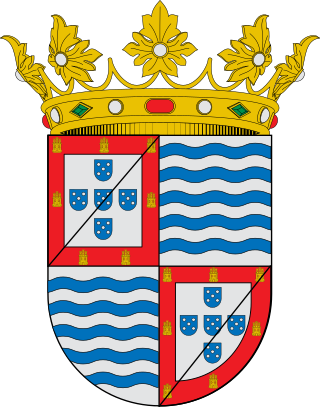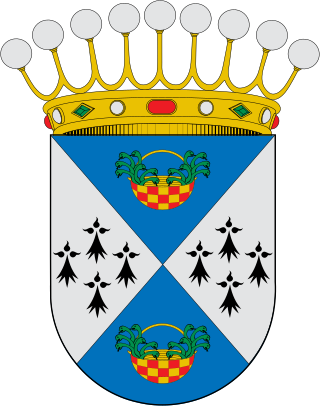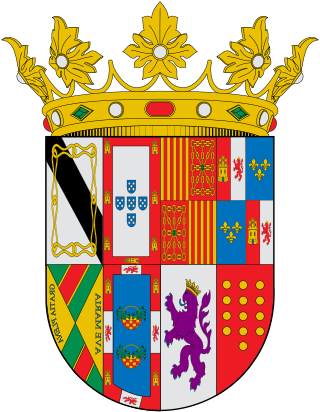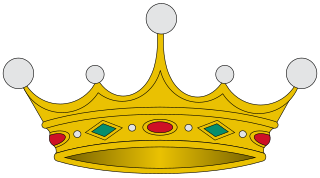
Spanish nobles are persons who possess the legal status of hereditary nobility according to the laws and traditions of the Spanish monarchy and historically also those who held personal nobility as bestowed by one of the three highest orders of knighthood of the Kingdom, namely the Order of the Golden Fleece, the Order of Charles III and the Order of Isabella the Catholic. A system of titles and honours of Spain and of the former kingdoms that constitute it make up the Spanish nobility. Some nobles possess various titles that may be inherited, but the creation and recognition of titles is legally a prerogative of the King of Spain.

Duke of Abrantes is a hereditary title in the Peerage of Spain, accompanied by the dignity of Grandee and granted in 1642 by Philip IV to Alfonso de Láncaster, son of the 3rd Duke of Aveiro and a great-grandchild of John II of Portugal. It takes its name from the city of Abrantes in Portugal.

Duke of Frías is a hereditary title in the peerage of Spain accompanied by the dignity of Grandee, created in 1492 by King Ferdinand II of Aragon and conferred to his son-in-law Don Bernardino Fernández de Velasco, 2nd Count of Haro, Constable of Castile, and Viceroy of Granada. It is one of the most important titles in Spain and one of the first titles to receive the honor of Grandee of Spain by Emperor Charles V in 1520.

Duke of Feria is a hereditary title in the Peerage of Spain accompanied by the dignity of Grandee, granted in 1567 by Philip II to Gómez Suárez de Figueroa, 5th Count of Feria.

Duke of Alcalá de los Gazules, commonly known as Duke of Alcalá, is an hereditary title in the Peerage of Spain accompanied by the dignity of Grandee, granted in 1558 by Philip II to Pedro Afán de Ribera, 3rd Marquess of Tarifa, Lord of Alcalá de los Gazules and Viceroy of Naples and Catalonia.

Count of Teba is a hereditary title in the Peerage of Spain, granted in 1522 by Charles I to Diego Ramírez de Guzmán, son of the 1st Lord of Teba. The name makes reference to the municipality of Teba, in Málaga, Spain.

Duke of Arión is an hereditary title in the Peerage of Spain accompanied by the dignity of Grandee, granted in 1725 by Philip V to Baltasar de Zúñiga, viceroy of New Spain.

Marquess of Portago is a hereditary title in the Peerage of Spain accompanied by the dignity of Grandee, granted in 1744 by Philip V to José Gómez de Terán y Delgado, Finance Treasurer and Council Minister of Spain.

Duke of Palata is a hereditary title in the peerage of Spain, accompanied by the dignity of Grandee and granted in 1646 by Philip IV to Francisco Toralto de Aragón, a paternal descendant of Alfonso V of Aragon. The title makes reference to the town of Palata in Campobasso, Italy, where Toraldo's father held a fiefdom.

Count of Baños is an hereditary title in the Peerage of Spain accompanied by the dignity of Grandee, granted in 1621 by Philip IV to Sancho Martínez de Leyva, iure uxoris Marquess of Leyva and knight of the Order of Santiago.

Count of Villada is a hereditary title in the peerage of Spain, granted in 1625 by Philip IV to Enrique Pimentel, a Spanish statesman who was son of the 2nd Marquess of Távara.

Count of Torre Arias is a hereditary title in the Peerage of Spain, accompanied by the dignity of Grandee and granted in 1761 by Charles III to María Francisca Colón de Larreátegui, in memory of her father, Pedro Colón de Larreátegui, knight of the Order of Alcántara.

Count of San Esteban de Cañongo is a hereditary title in the Peerage of Spain, granted in 1816 by Ferdinand VII to Agustín José Ramón Valdés, colonel of the cavalry militias of Habana.

Duke of Santisteban del Puerto is a hereditary title in the Peerage of Spain accompanied by the dignity of Grandee, granted in 1738 by Philip V to Manuel de Benavides, 10th Count of Santisteban del Puerto and Brigadier of the Spanish Army.

Marquess of Moratalla is a hereditary title in the Peerage of Spain, granted in 1681 by Charles II to Francisco Luis Fernández de Córdoba, Lord of Belmonte and Moratalla.

Count of Salvatierra is a hereditary title in the Peerage of Spain, accompanied by the dignity of Grandee and granted in 1613 by Philip III to Diego Sarmiento de Sotomayor, Lord of Salvaterra and of the Castle of Sobroso.

Count of Altamira is a hereditary title in the Peerage of Spain, accompanied by the dignity of Grandee and granted in 1455 by Henry IV to Lope Sánchez de Ulloa, Lord of the Fortress of Altamira.

Duke of Baena is a hereditary title in the Peerage of Spain, accompanied by the dignity of Grandee and granted in 1566 by Philip II to Gonzalo Fernández de Córdoba II, who was the 7th Lord of Baena, 5th Count of Cabra and 3rd Duke of Sessa, Santángelo, Terranova, Andría and Montalto.

Viscount of la Armería is a hereditary title in the Peerage of Spain, granted in 1694 by Charles II to José de Aldaz y Aguirre, owner of two of the most important armouries in Spain, the "Real Fábrica de Armas de Orbaizeta" and the "Real Fábrica de Municiones de Olaverri", hence the name of the title.




















